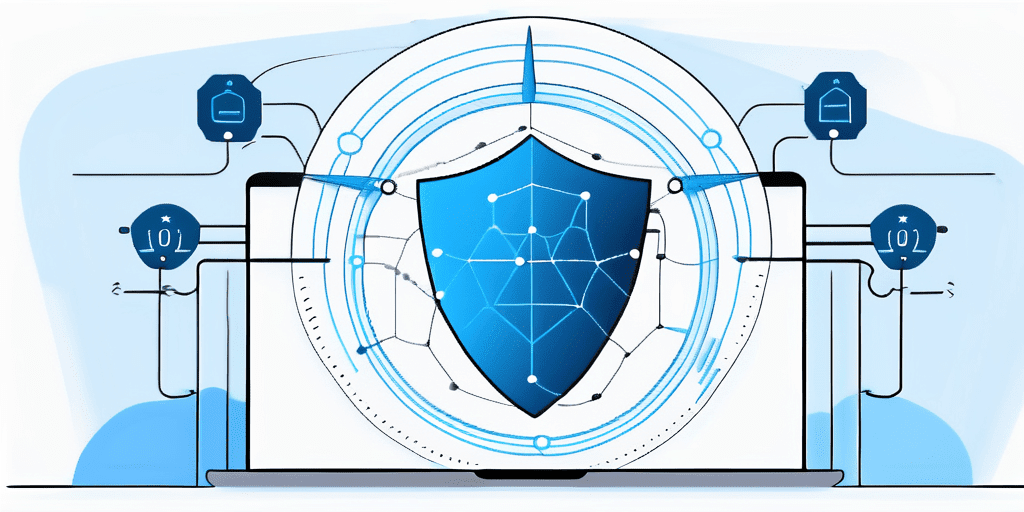CVSS, short for Common Vulnerability Scoring System, is a widely used method for assessing the severity of security vulnerabilities. It provides a standardized framework that helps organizations prioritize and mitigate vulnerabilities effectively. In this comprehensive guide, we will explore the basics of CVSS, its components, how to interpret CVSS scores, the differences between CVSS versions, best practices for implementation, and the future of CVSS in the ever-evolving cybersecurity landscape.
Understanding the Basics of CVSS
CVSS aims to provide a quantitative measure of a vulnerability’s potential impact, making it easier for security professionals to prioritize their remediation efforts. To grasp the concept better, let’s delve into the definition and purpose of CVSS.

Definition and Purpose of CVSS
The Common Vulnerability Scoring System (CVSS) is an open standard that assigns a severity rating to vulnerabilities discovered in various software products. It helps security analysts assess the impact and exploitability of a vulnerability, aiding in risk analysis and vulnerability management. Developed by the National Infrastructure Advisory Council (NIAC), CVSS provides a consistent and objective way to evaluate vulnerabilities and prioritize responses.
CVSS takes into account various factors when calculating a vulnerability’s score, including the vulnerability’s access complexity, authentication requirements, and potential impact on confidentiality, integrity, and availability. By considering these aspects, CVSS offers a comprehensive view of the risk posed by a particular vulnerability, allowing organizations to make informed decisions about mitigation strategies.
The Importance of CVSS in Cybersecurity
In today’s world, where cyber threats are on the rise, having a standardized system like CVSS is crucial. It enables organizations to assess the severity of vulnerabilities consistently, irrespective of the software or system affected. This uniformity helps security teams make informed decisions when allocating resources to address vulnerabilities, reducing the chances of overlooking critical security flaws.
Furthermore, CVSS facilitates communication and collaboration among different stakeholders in the cybersecurity ecosystem. Security researchers, vendors, and organizations can use the CVSS scores to exchange information about vulnerabilities effectively. This shared understanding enhances the overall security posture of the industry by promoting transparency and timely remediation of security issues.
The Components of CVSS
CVSS, which stands for Common Vulnerability Scoring System, is a framework used to assess the severity of security vulnerabilities. It consists of several components grouped into three metric groups: Base, Temporal, and Environmental. Each of these groups plays a crucial role in providing a comprehensive understanding of the risk posed by a particular vulnerability.
Base Metric Group
The Base Metric Group is the foundation of the CVSS score calculation process. It focuses on the inherent characteristics of a vulnerability that remain constant regardless of the time or environment. Metrics within this group, such as exploitability, impact, and complexity, help security analysts determine the fundamental aspects of a vulnerability’s risk profile.
Temporal Metric Group
As vulnerabilities evolve over time, the Temporal Metric Group becomes essential in assessing their changing nature. This group considers time-specific factors like the availability of patches, exploit code maturity, remediation level, and report confidence. By incorporating these metrics, the Temporal group provides a dynamic perspective on the vulnerability’s risk, reflecting the current state of its exploitability and mitigation measures.
Environmental Metric Group
Recognizing that vulnerabilities can have varying impacts depending on the environment in which they are present, the Environmental Metric Group offers a customized approach to scoring. Organizations can tailor the CVSS score to their specific circumstances by considering factors such as collateral damage potential and the characteristics of the affected user community. This group enables a more personalized risk assessment, allowing organizations to prioritize their response efforts based on the unique context in which the vulnerability is situated.
Interpreting CVSS Scores
Understanding how to interpret CVSS scores is essential for effectively prioritizing vulnerabilities. Let’s explore the meaning of different score ranges and how to calculate a CVSS score.

CVSS scores are a critical component in the realm of cybersecurity, providing a standardized method for assessing the severity of vulnerabilities. These scores play a crucial role in helping security professionals determine the level of risk posed by a particular vulnerability and prioritize their remediation efforts accordingly.
Score Ranges and Their Meanings
CVSS scores range from 0.0 to 10.0, with 10.0 being the most severe. Scores in the range of 0.1 to 3.9 are considered low impact, indicating vulnerabilities that may not pose a significant threat to the system. On the other hand, scores between 4.0 and 6.9 suggest a medium level of impact, highlighting vulnerabilities that could potentially lead to some adverse consequences if exploited.
Furthermore, scores ranging from 7.0 to 8.9 represent high impact vulnerabilities, signifying a significant threat to the system’s security and integrity. Finally, those falling within the range of 9.0 to 10.0 indicate critical vulnerabilities that demand immediate attention and swift remediation to prevent potential security breaches.
Calculating a CVSS Score
To calculate a CVSS score, one must delve into the intricacies of the Base, Temporal, and Environmental groups, each comprising specific metrics that contribute to the overall severity assessment. These metrics, such as exploitability, impact, and environmental factors, play a pivotal role in determining the final CVSS score for a vulnerability.
By meticulously assigning values to these metrics based on the provided options and applying the corresponding weights, organizations can derive a comprehensive CVSS score that accurately reflects the severity of the vulnerability at hand. This calculated score serves as a valuable tool in guiding cybersecurity professionals towards making informed decisions regarding vulnerability management and mitigation strategies.
CVSS Version Differences
CVSS, like any other framework, evolves over time to address emerging challenges and incorporate new learnings. As the cybersecurity landscape continues to evolve, the Common Vulnerability Scoring System (CVSS) has undergone several iterations to ensure it remains a robust and effective tool for assessing vulnerabilities. Let’s delve deeper into the key changes between CVSS versions and the advancements introduced in CVSS v3.1.
One of the fundamental aspects of CVSS is its ability to provide a standardized method for rating vulnerabilities, allowing organizations to prioritize their responses based on the severity of the threat. Understanding the differences between CVSS versions is crucial for security professionals to accurately assess and mitigate risks.
CVSS v2 vs v3: Key Changes
CVSS version 3 introduced significant enhancements to the scoring system, marking a notable shift from its predecessor, CVSS v2. It incorporated a broader scope of metrics, improved granularity, and an increased emphasis on user impact. The key changes include the introduction of the vector string format, which allows for a more precise representation of vulnerabilities, the addition of scope and user interaction metrics to better capture the impact of a vulnerability, and the transformation of environmental metrics from optional to mandatory, providing a more comprehensive view of the potential impact on an organization.
Advancements in CVSS v3.1
Building upon the foundation laid by CVSS v3, version 3.1 further refines the scoring system by focusing on existing metrics and introducing new ones to enhance its accuracy and relevance. By incorporating feedback from the cybersecurity community and industry experts, CVSS v3.1 ensures that it remains a dynamic and adaptive framework capable of addressing the evolving threat landscape. These advancements reflect the ongoing commitment to improving the effectiveness of vulnerability assessments and aiding organizations in making informed decisions to protect their assets and data.
Implementing CVSS in Your Organization
Now that we understand the basics of CVSS, let’s explore best practices for using CVSS and common misconceptions to avoid.

Implementing the Common Vulnerability Scoring System (CVSS) in your organization can significantly enhance your cybersecurity posture. By utilizing CVSS, you can effectively prioritize vulnerabilities based on their severity and potential impact on your systems. This structured approach allows for a more systematic and informed decision-making process when addressing security issues.
Best Practices for Using CVSS
When implementing CVSS in your organization, it is essential to follow best practices to achieve accurate vulnerability prioritization. Some best practices include consistently applying CVSS during vulnerability assessments, integrating CVSS with existing vulnerability management processes, and ensuring proper training and education on the CVSS framework.
Furthermore, establishing clear communication channels within your organization regarding the use of CVSS can streamline the vulnerability management process. Regularly updating and reviewing the CVSS scores assigned to vulnerabilities ensures that your security team stays informed about the evolving threat landscape and can respond proactively.
Common Misconceptions and Pitfalls
While CVSS is a valuable tool, it is essential to be aware of common misconceptions and pitfalls. For instance, relying solely on the CVSS score without considering the specific context of your environment could lead to flawed decision-making. Additionally, misinterpreting metrics or neglecting to consider the potential impact on business operations could result in suboptimal vulnerability management.
Another common pitfall to avoid is overlooking the temporal aspects of vulnerabilities when using CVSS. Failing to account for factors such as exploit availability or remediation level can skew the prioritization of vulnerabilities and leave your organization exposed to potential threats. It is crucial to take a holistic approach to vulnerability management and consider all relevant factors beyond just the CVSS base score.
The Future of CVSS
As the cyber threat landscape continues to evolve, the future of CVSS looks promising. Let’s explore predicted developments and improvements.
Predicted Developments and Improvements
CVSS is expected to continue evolving to address emerging challenges in the cybersecurity domain. This includes the refinement of existing metrics, introducing new ones to cover previously unaddressed aspects, and incorporating feedback from the security community. The aim is to make CVSS more comprehensive, accurate, and adapted to meet the evolving needs of organizations’ vulnerability management processes.
One predicted development is the incorporation of machine learning and artificial intelligence (AI) algorithms into CVSS. By leveraging these technologies, CVSS can analyze vast amounts of data and identify patterns that human analysts might miss. This would enhance the accuracy of vulnerability assessments and enable organizations to prioritize remediation efforts more effectively.
The Role of CVSS in Evolving Cybersecurity Landscape
In an era where cyber threats are constantly evolving, the role of CVSS in the cybersecurity landscape is critical. By providing a standardized method to assess vulnerabilities, CVSS equips organizations with valuable insights to prioritize remediation efforts effectively. It enables organizations to make informed decisions, allocate resources efficiently, and ultimately enhance their overall security posture.
Furthermore, CVSS is not only useful for organizations but also for security researchers and vendors. It allows them to communicate the severity of vulnerabilities in a consistent and understandable manner. This facilitates collaboration and knowledge sharing within the cybersecurity community, leading to faster and more effective vulnerability mitigation strategies.
As the threat landscape expands to include emerging technologies such as Internet of Things (IoT) devices and cloud computing, CVSS will need to adapt accordingly. Future versions of CVSS may introduce specific metrics and scoring mechanisms tailored to these new technologies, ensuring that vulnerabilities in these areas are accurately assessed and prioritized.
In conclusion, CVSS plays a vital role in the field of vulnerability management, providing a standardized framework for assessing the severity of vulnerabilities. Understanding the basics of CVSS, interpreting CVSS scores accurately, and implementing best practices within your organization can significantly enhance your cybersecurity posture. As CVSS continues to evolve, it promises to adapt to the changing threat landscape, ensuring it remains a valuable tool for organizations worldwide.
As you navigate the complexities of CVSS and its implications for your cybersecurity strategy, remember that expert guidance is invaluable. Blue Goat Cyber, a Veteran-Owned business, specializes in a comprehensive range of B2B cybersecurity services tailored to your needs. From medical device cybersecurity to HIPAA and FDA compliance, and from SOC 2 to PCI penetration testing, our team is dedicated to fortifying your defenses against cyber threats. Contact us today for cybersecurity help and ensure your organization’s vulnerabilities are assessed, prioritized, and mitigated with precision and expertise.
